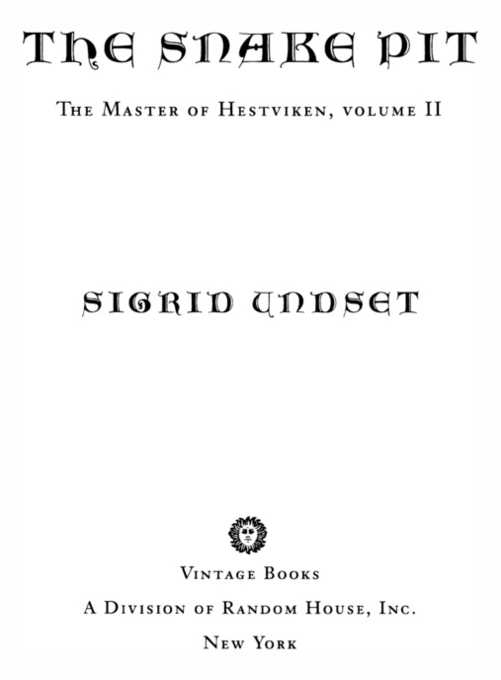The Snake Pit

VINTAGE BOOKS EDITION
Copyright © 1929 by Alfred A. Knopf, Inc.
Renewal Copyright 1957 by Alfred A. Knopf, Inc.
All rights reserved under International and Pan-American Copyright Conventions. Published in the United States by Vintage Books, a division of Random House, Inc., New York, and simultaneously in Canada by Random House of Canada Limited, Toronto. Originally published in hardcover in Norwegian by H. Ascheboug & Company, Oslo. Copyright 1925 by H. Ascheboug & Company, Oslo. This translation was published in hardcover as part of The Master of Hestviken by Alfred A. Knopf, Inc., New York, in 1930.
Translated from the Norwegian by Arthur G. Chater
Library of Congress Cataloging-in-Publication Data
Undset, Sigrid, 1982 – 1949.
[Olav Audunssøn i Hestviken. I. English]
The snake pit / Sigrid Undset.
p. cm.—(The master of Hestviken / Sigrid Undset; v. 2)
Originally published in Norwegian as part 2 of Olav Audunsson i Hestviken (2 v.).
eISBN: 978-0-307-77307-4
1. Norway—History—1030 –1397—Fiction.
2. Middle Ages—History—Fiction.
I. Title. II. Series: Undset, Sigrid, 1882 – 1949.
Master of Hestviken; v. 2.
PT8950.U5061613 1994
839.8’2372—dc2o 94-16660
v3.1
Contents
Cover
Title Page
Copyright
Chapter 1
Chapter 2
Chapter 3
Chapter 4
Chapter 5
Chapter 6
Chapter 7
Chapter 8
Chapter 9
Chapter 10
Chapter 11
Chapter 12
Chapter 13
Chapter 14
Chapter 15
About the Author
Other Books by This Author
Books by Sigrid Undset
I
HESTVIKEN had been a seat of chieftains in old time. Traces of many great boat-sheds could still be seen by the waterside, and rotting logs strewed the slope over which the Hestvik men had drawn their longships in spring and autumn. They showed like the remains of an old roller-way, reaching from high-water mark up to the little plain between the crags.
Then Christian faith and morals came to Norway; Saint Olav forbade his subjects to go a-viking. Men were to believe, whether they liked it or no, that God will not suffer a man to rob his even Christian, even though he be of strange race. The Hestvik men sailed on merchant voyages, and from of old shipbuilding had been carried on at Hestviken. Even Olav Ribbung, while he was in his best years, kept a shipwright at his manor, and when, after the Birchlegs1 had burned Hestviken, he rebuilt both the manor farm on the high ground and the houses by the shore, he set up the boat-house and the two sheds and the workshop as they stood to this day down by the hithe.
A couple of hours’ rowing southward from the Thingstead, Haugsvik, brings one to a lofty crag; this great dull-red rock, which falls abruptly to the fiord and is bare of trees to near its summit, is called the Bull. Behind the point Hestviken runs up into the land; it is a small and rather narrow creek. On its northern side the Bull Crag falls sheer into the sea, and below it is deep, dark water. Upon the neck of the Bull grow sparse and wind-bent firs, but they thicken farther up the height—the promontory is like a foot thrust out into the sea from the low ridge, which extends on the whole northern side of the inlet and of Hestviksdal or Kverndal, as it is also called,2 eastward into the heart of the district. Inland along the valley the ridge falls steeply to the watercourse—a little stream runs through Kverndal and comes out into the sea at the head of the creek.
1 comment